




Your support is critical to our success.
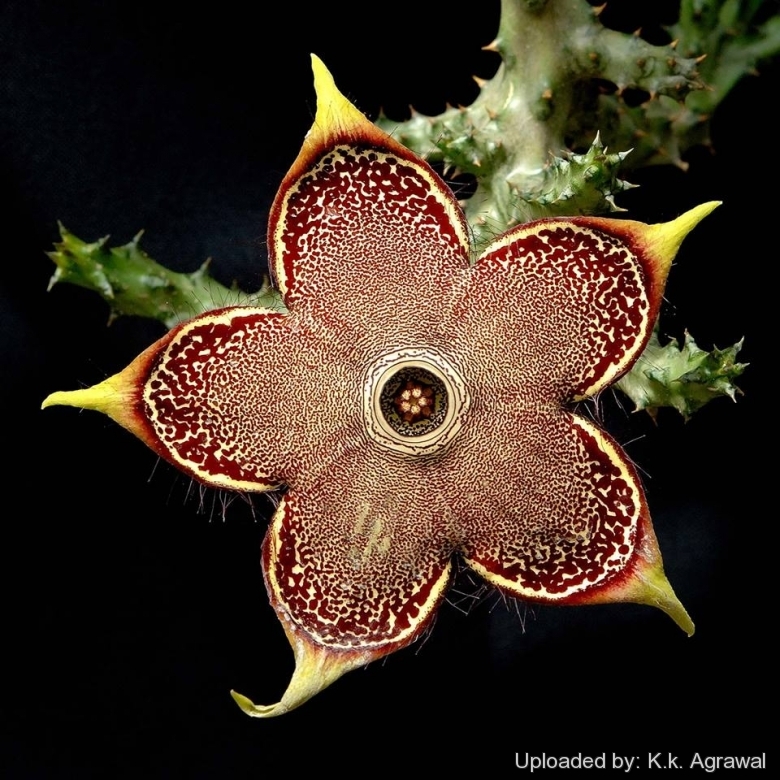
Origin and Habitat: Edithcolea grandisSN|26305]]SN|26305]] is distributed throughout the African Great Lakes region (Kenya, Tanzania, Uganda ), the Horn of Africa (Ethiopia, Somalia, Djibouti) and Yemen (including the Socotra archipelago).
Altitude range: 200–1500 metres above sea level.
Habitat: The plant is found in dry and arid regions. Sometimes in full sun, but mostly partly shaded by rocks and shrubby vegetation.
Synonyms:
- Edithcolea grandis N.E.Br.
Edithcolea grandis N.E.Br.
Bull. Misc. Inform. Kew 220 1895
Synonymy: 3
- Edithcolea grandis N.E.Br.
- Edithcolea grandis var. baylissiana Lavranos & D.S.Hardy
- Edithcolea sordida N.E.Br.
CHINESE (中文): 巨龙角, 波斯地毯
Description: Edithcolea grandisSN|26305]]SN|26305]] is a one of the handsomest and most distinct of all the Stapelioid group. The remarkable flower is at times described as the Persian carpet flower.
Habit: It is a leafless richly branched perennial succulent that spread over the ground forming large cushions.
Stems: Glabrous 4-5-angled, decumbent at the base 10–15 mm thick in diameter and growing to about 30 cm in length, glabrous green to red with brownish spots, angles armed with hard brown very acute spine-like teeth.
Inflorescences: Subsolitary, formed near the tip of the branches; pedicels 14-18 mm long, 2-2,5 mm thick, glabrous.
Flowers: Bisexual (3-)8-12(-13) cm in diameter. Sepals 8 mm long, 2-3 mm broad, ovate-lanceolate, acuminate, probably recurved at the somewhat pungent tips. Tube short about 5 mm in diameter and 3-4 mm deep, with a slightly elevated acute rim around its mouth, glabrous. Corolla 5-lobed rotate or saucer-shaped, glabrous on the back, disk rugose with concentric ridges and furnished with long clavate purple hairs radiating from the centre to the sinuses, otherwise glabrous, apparently whitish or pale yellowish with a purple-reddish pattern of spots that gradually become smaller at the base of each lobe where they merge in concentric arcs; lobes 4-5 cm long, 2,5-3 cm broad, ovate to broadly triangular, acute, reflexed, bordered with long clavate purple hairs to about the middle, margin of corolla and the apical portion of the lobes usually uniformly purple or greenish-brown, with a fringe of long club-shaped purple hairs that also border them on the inner side and extend in five radial lines from the sinuses between the lobes to the outer rim of the tube. The back of the flower is yellow to green. Inner corolla relatively small. Outer coronal-lobes 0,7-1 mm long, subquadrate or transversely oblong, acutely bifid, with a broad shallow sinus between the points, concave and hairy within; inner coronal-lobes 0,8-1 mm long, strap-shaped in their middle portion, joined above the staminal column, minutely tuberculate, keeled on the inner face, glabrous. Pollinia nearly 0,5 mm long. Pollen-carrier narrow, rather more than half as long as the pollinia. The carrion-like smell of the flowers attracts flies and other insects for pollination.
Fruit (follicles): Flies pollinated, the flowers resulting in the typical twin seed horns (follicles), which are decorative in themselves and contain a large number of seeds.
Seeds: Oval shaped bear a tuft of hairs (coma) so they can be dispersed with the wind.
Subspecies, varieties, forms and cultivars of plants belonging to the Edithcolea grandis group
 Edithcolea grandis N.E.Br.
Edithcolea grandis N.E.Br.- Edithcolea grandis var. baylissiana Lavranos & D.S.Hardy: has more branched stems that are smaller in diameter (1 to 1,5 cm), shorter (10 cm) and are often spirally twisted.
Notes: These plats are pollinated by flies (myiophilous pollination). Fly are attracted by olfactory stimuli, imitating dung or decaying organic (zoogenic or phytogenic) matter, together with mimetic colouration and, sometimes mimetic sculpturing. Nectar is present. The nectar mainly serves as optical attractant causing brilliance effects, and as visitor guide. However, nectar obviously is also a reward. In the pollination process flies carry pollinaria only at the distal parts of their proboscis, never on their legs. The pollinator spectra are similiar between of flowers in habitat and cultivated ones.
Bibliography: Major references and further lectures
1) N. E. Brown “Flora of Tropical Africa”, Vol 4 Part 1, page 231 1904
2) D.V. Field. Edithcolea grandis. Asklepios 20: 18-21, 1980.
3) J.J. Lavranos & D.S. Hardy. "Edithcolea grandis var. baylissiana" Lavranos & Hardy. Asklepios 20: 21-23, 1980.
4) Focke Albers und Ulrich Meve “Illustrated handbook of succulent plants”, Volume 3. Springer-Verlag 2002
5) Sigrid Liede-Schumann und Ulrich Meve “The Genera of Asclepiadoideae, Secamonoideae and Periplocoideae (Apocynaceae): Edithcolea” Online.
6) PROTA 2: “Vegetables / Légumes” 2004, page 292. Backhuys Publishers.
7) N. E. Brown in: Daniel Oliver, L. Reeve “Flora of Tropical Africa” Vol 4 Part 1, page 231 1904
8) Amare Getahuna. “The role of wild plants in the native diet in Ethiopia Agro-Ecosystems.” Volume 1, 1974, Pages 45–56.
9) Mats Thulin “Flora of Somalia” Volume 3 Royal Botanic Gardens, Kew, 2006
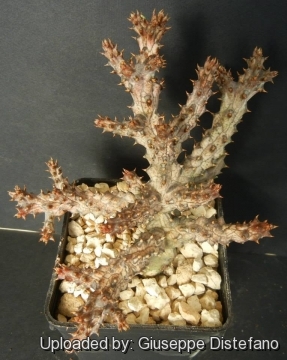
Edithcolea grandis Photo by: Giuseppe Distefano

Edithcolea grandis Photo by: Raffa C. Garcia
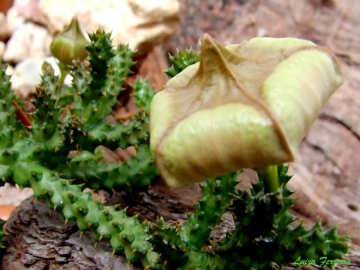
Edithcolea grandis Photo by: Luiza Ferreira
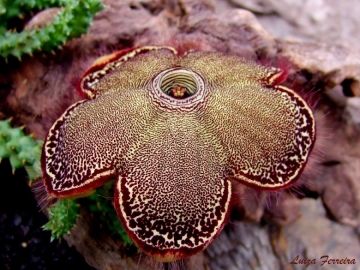
Edithcolea grandis Photo by: Luiza Ferreira

Edithcolea grandis Photo by: Raffa C. Garcia

Edithcolea grandis Photo by: K.k. Agrawal
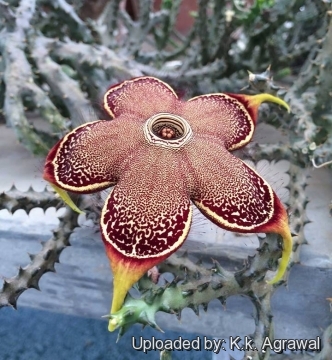
Edithcolea grandis Photo by: K.k. Agrawal
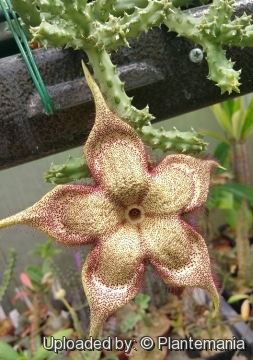
Edithcolea grandis From Las Anod lake (pale flowered form) Photo by: © Plantemania
Cultivation and Propagation: Edithcolea grandisSN|26305]]SN|26305]] is a particularly difficult plant to keep because of its very specific growing needs with much light and relatively high (above 15°C) winter temperatures. It’s very susceptible to rot in combination with low temperatures, but given the right growing conditions it is an easy blooming plant.
Watering: It require moderately watering through the growing season but enjoy plenty of water and some fertiliser in hot weather and allow them to dry before watering again , this helps them to flower freely. Water sparingly in winter according to temperatures. But, as with most asclepiads, it is unwise to leave them wet in cold weather. Winter care presents no problems at 15°C with plenty of light. Since roots are quite shallow, use a cactus mix or add extra perlite or pumice to regular soil potting soil. A gritty, very free-draining compost is suitable, and clay pots help the plants to dry out between watering.
Sun Exposure: Partial sun or light shade
Pest and diseases: They are very susceptible to stem and root mealy bugs, and damage from these may well initiate fungal attack. If you do have problems with a stem or with basal rotting, you can reliably isolate the healthy parts, dry them off, and re-root them in moist compost.
Cultural Practices: Re-pot every 2 years.
Traditional uses: The stem of Edithcolea grandisSN|26305]]SN|26305]] is eaten as a vegetable in Ethiopia and Somalia.
Propagation: Easiest with stem cuttings. Allow cuttings to dry a day before planting. Stems must be laid (Not buried) on gritty compost and will then root from the underside of the stems. It can also be increased from seeds sowing in spring in moist, sandy peat moss.
Potting medium: Since roots are quite shallow, use a cactus mix or add extra perlite or pumice to regular soil potting soil. A gritty, very free-draining compost is suitable, and clay pots help the plants to dry out between watering.
| Your Actions | |
|---|---|
| Back to Edithcolea index | |
| Back to Asclepiadaceae index | |
 |
Back to Succulents Encyclopedia index |
Privacy stantement - Terms and conditions - How to cite - About us - Feedback - Donate




